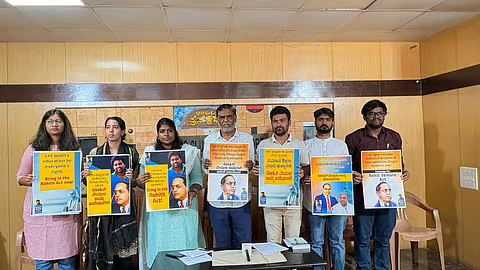Vulture Population Survey in 3 States
States Involved:
- Karnataka,Tamil Nadu,Kerala
Survey Conducted By:
- Forest Departments of the three states
- Supported by various wildlife and conservation organizations
Key Findings of the Survey (2023-24)
- Total Vulture Count: Increased from 320 (last year) to 390 vultures this year.
- Total Survey Area: 28 forest zones across Karnataka, Tamil Nadu, and Kerala.
- Date of Survey: Conducted on February 27, 2024.
Breakdown of Vultures Counted (Species-wise):
- White-rumped Vulture (Gyps bengalensis): 157
- Long-billed Vulture (Gyps indicus): 110
- Red-headed Vulture (Sarcogyps calvus): 31
- Egyptian Vulture (Neophron percnopterus): 11
- Himalayan Griffon (Gyps himalayensis): 5 (migratory species spotted in the Western Ghats)
Vulture Count by Region in Karnataka:
- Ramnagar: 119,Chamarajanagar: 77,Ballari: 8,Vijayapura: 23
Total in Karnataka: 125 vultures
International Recognition for Kannada Artist Sheela Gowda
Award Details:
- Award Name: Sam Gilliam Award 2025
- Awarded By: Dia Art Foundation & Sam Gilliam Foundation (jointly)
- Prize Money: ₹63.49 lakhs (USD 75,000)
Educational Background:
- 1979: Bachelor’s degree in Art from Ken School of Art, Bengaluru
- 1982: Graduated from Visva Bharati University, Santiniketan
- 1986: Master’s degree from Royal College of Art, London
Artistic Style & Contributions:
- Known for Post-Minimalist art
- Works often express empathy for laborers and working-class lives
- Uses unconventional materials in art:
- Human hair
- Cow dung
- Incense sticks
- Saffron
- Has created both paintings and sculptures
Her art is displayed in national and international galleries and museums
Merger of Two Regional Rural Banks in Karnataka
Tagline: “One State – One Regional Rural Bank”
What’s Happening?
- The Government of India has initiated a merger of:
- Karnataka Gramin Bank
- Karnataka Vikas Grameena Bank
- The merger is being done under the “One State – One Grameena Bank” policy to improve operational efficiency.
Background:
- Both banks are operating under NABARD supervision.
- A decision was taken to merge these banks under RBI Act Section 42 and implemented from April 1, 2024.
Key Features of the Merger:
- Total branches post-merger: 1,224
- Total employees affected: More than 10,000
- Total customers served: 5 crore+
- Combined service coverage: All districts of Karnataka
Headquarters:
Dharwad will serve as the new headquarters for the merged entity.
Central Government's Initiative – Sahkar Taxi
- Announcement by: Union Home Minister & Minister of Cooperation Amit Shah.
- Name of the Scheme: Sahkar Taxi – a cooperative ride-hailing platform.
- Aim:
- To bring all two-wheelers, taxis, autorickshaws, and four-wheelers under a cooperative model.
- Revenue to go directly to drivers (unlike private aggregators charging high commission).
Karnataka Government’s Initiative – Still in Limbo
- In 2023, the Karnataka Transport Department announced plans for a State-run ride-booking app.
- Aim: Provide a non-exploitative alternative to private aggregators.
- App development was handed over to the e-Governance
Namma Yatri – A Driver-Centric Alternative
- Launched by Auto Rickshaw Driver Union (ARDU).
- Based on ONDC (Open Network for Digital Commerce).
- Developed by: Juspay Technologies Pvt. Ltd.
- Highlights:
- No commission-based exploitation.
- Direct link between driver and customer.
- However, it’s still a small player compared to big aggregators.
Policy & Regulation Gaps
- In 2022, Bengaluru Auto Drivers’ Unions urged government to:
- Act against illegal bike taxis and unregulated apps.
Lack of proper regulation led to the rise of independent apps like Namma Yatri.
Protest at Freedom Park, Bengaluru – Demand for Rohith Act
- Organized by:
- Students, activists, and progressive organisations.
- State government to announce steps to implement the ‘Rohith Act’.
Context & Legacy
- Tribute paid to:
- Babu Jagjivan Ram, former Deputy Prime Minister of India.
Why the Rohith Act?
- Purpose:
- To end caste-based atrocities and discrimination against Dalit and Bahujan students in educational institutions.
- Concern raised:
- Rise in institutional deaths of Dalit students in universities.
- Existing laws like the SC/ST (PoA) Act lack specific provisions for educational institutions.
About the Rohith Act (Proposed)
- Named after: Rohith Vemula, a Dalit research scholar who died by suicide in 2016, allegedly due to caste discrimination.
- Goal:
- Create institutional safeguards.
Establish accountability mechanisms in educational institutions to protect Dalit and Bahujan students.






